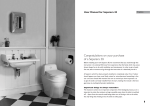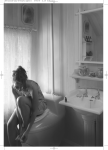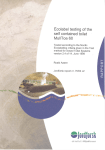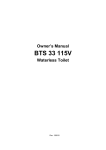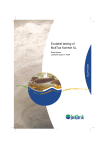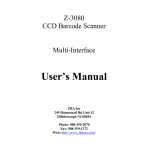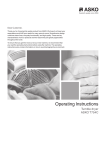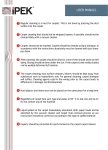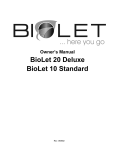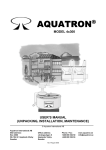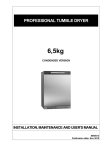Download 40 - pdf
Transcript
User Manual for Separera 40 User Manual for Separera 40 Congratulations on your purchase of a Separera 40. Before installing your new Separera 40, we recommend that you read through this instruction in its entirety. We know from experience that the faults which may occur, almost always has to do with installation and maintenance. In order to get a hassle free use, take a moment and go through the instruction. It is absolutely worth it. A Separera which has been properly installed, is completely odour free. If odour should appear, you have most likely missed or misunderstood something in the use- and care manual. We mention this now to remind you how important it is to get the toilet correctly installed from the start; reading this manual is the best guarantee to reaching full product satisfaction. Important things to always remember: The moisture content is an important component of the biological process, so it is important to retain the moisture as long as possible, even when the toilet is switched off. – Apart from the natural needs being taken care of during a visit to the toilet, the only thing that should go into the toilet is toilet paper. 1 How the Separera 40 works This urine separating toilet is constructed from eco-friendly material and is designed to cope with high demand over many years.What does separating waste mean? Well, the toilet is designed so that on any toilet visit, solid waste is separated from the liquid (urine).This means that Separera has two chambers, one for urine, and another for solid waste. Both must be dealt with in accordance with local regulations. Contacting Environmental Health Contact Environmental Health office regarding local health regulations. This always applies when installing any type of toilet. The Separera box contains Toilet with fan • Lid• Urine hose (1.5 m) • Screw with washer for wall bracket according to option A • Special Humus • Ventilation Pipe 50 cm for wall • Mesh Cover • 2 Composting Chambers (40 litres) • Latrine Bags (10) The installation kit (accessories) The installation kit contains; ventilation pipes (4x1.1 m ventilation pipe with 55 mm outer diameter), exterior pipe (1 x 1.1m with 110 mm outer diameter), insulation (2 x 1 m), reducing coupling, roof flashing and insect netting. The connection kit used in installation option B can be ordered by your retailer Further accessories Pipe Bends 30° and 45°, Insulation,Ventilation Pipe, Special Humus, Ejector Tank, Latrine Bags. Separera in cross section 1. Lid for vegetable waste 2. Upper section 3. Toilet seat 4. Air intake 5. Screen 6. Urine bowl 7. Urine hose 8. Lower section 9. Hose connection 10. Fixing holes 11. Floor bushing 12. Connector pipe 13. Composting chamber 14. Cord with plug 15. Inner container 16. Nylon clips 17. Fan kit 18. Wall bracket 19. Lid 1 2 3 19 4 5 18 6 17 16 15 14 7 8 10 10 9 13 12 2 11 MAINTENANCE Urine drainage Electrical connection Urine can be drained away in a number of different ways. Check what is required by your local authority; there are variations depending on ground conditions and the water table.You should never just deal with it as you see fit, as this could have a harmful effect. A household of 4 people will produce around 35 litres of urine per week; this is equivalent to about 3 kg of artificial fertiliser, which is a considerable amount. There must be a drop in the hose coming out and away from the toilet to avoid salt deposits; for longer hoses, it may be helpful to connect it to a 32 mm PVC pipe. Separera is approved for installation in wet rooms. For permanent installation, a qualified electrician must install a multi-pole switch. If the mains supply cable is damaged it must be replaced by the manufacturer or another qualified person. GREY WATER: Connect the hose to an existing drainage system such as a percolation basin or similar. It is important that pipes have enough of a drop for urine not to remain standing in the hose. If necessary, the hose may be angled to create a water trap. In this case it is important to pour through a litre of hot water now and again to prevent the build-up of salt deposits in the hose. With normal use, a family of four produces around 7 litres of solid waste per week. To create compost that is nice and loose, add a few litres of Special Humus once a week. You need to base the emptying frequency on how often the toilet is used and by how many people. For example, after 4-6 weeks’ use by 4 people it will be time to switch composting chambers. Lift out the inner container and carry it out, add a little ordinary topsoil and put the lid on. Place the container in a shady place in the garden for post-composting. It takes 6 to 9 months of post-composting as a rule before the contents can be used as a fertiliser. Put a latrine bag in the other inner container and fit this in place beneath the toilet. Grey water drainage INFILTRATION: May consist of a pit or a ditch outside the house. Put large stones/macadam around the hose mouth and then fill with sand. EJEKTORTANK: If you want to use the urine as liquid fertiliser, there is a special tank available as an accessory; it can be ordered from your dealer or from us. Urine contains large quantities of nutrient salts, making it a useful fertiliser for lawns.With the ejector tank you get the correct dilution for watering; connection to 1/2” garden hose. Solid waste General advice Infiltration Wash the urine bowl with water now and again to prevent salt deposits. If insects get into the toilet, you can sprinkle BioLet Insektsstopp on the compost. If you do experience a bad smell in the room, check the pipe connections are properly sealed and that there is an adequate air supply. To clean the toilet, use only mild detergent. Never use abrasive cleaning agents. If you leave the house for more than 2 days, switch off the fan and put the lid down. If there is a good natural. Ejector tank 3 INSTALLATION The toilet room itself FAN 300 m m The toilet can be placed anywhere you like; it does not need to have a particular room temperature. However, the composting process will be more rapid in a warmer room, as the microorganisms thrive in a warm environment. It must be possible to conduct urine away from the toilet. Separera is therefore most suitable as a summer toilet, as there may be problems with managing the urine in wintertime. Option A: 370 mm Option B: 415 mm snapcoupling Air supply ejectortank Make sure there is a good air supply, for example, through a 10 mm gap under the door or via a vent. Air will be evacuated via the toilet, so cross-draughts must be avoided. SOLID WASTE URINE • Pass the urine hose through the floor and seal with silicone. Ventilation • Set the lower section in position and seal between Ventilation can be either via an external wall or up through the roof. the floor and the toilet. Fit the floor bushing to the toilet and through the floor. Connect the urine hose to the urine bowl, making sure there are no kinks in the hose. Fix the hose in place using hose clamps, being careful not to damage the nipple. Option A – ventilation through external wall The toilet is accompanied by an installation kit according to Option A. • Lift off the upper section (2) of the toilet, remove the inner container (15) and floor bushing (11). • Position the lower section (8) against the external wall of the room. Use the accompanying washers, 10 mm, to get the correct distance from the wall before marking. • Mark for wall bracket, ventilation pipe, floor bushing and hose. • Fit the ventilation pipe and seal against the external wall using silicone. On the outside the pipe must be properly sealed against the external wall. Fit the mesh cover. 4 securely to the floor. • Fit the inner container using the plastic clips. • Screw the toilet securely to the wall using screws and washers. • Replace the upper section. • Place the composting chamber on a level surface immediately beneath the toilet FAN • Drill a hole in the external wall for the ventilation pipe 55 mm, hole centre 300 mm from the floor. Saw holes for the floor bushing and for the urine hose, 25 mm. • Fit the ventilation pipe to the fan kit (17). • Screw the floor bushing and the lower section • Measure from the upper edge of the composting chamber to the lower edge of the floor bushing, add 10 cm, and then cut the connection pipe. The stop edge of the pipe must be up against the composting chamber. through screws with nuts Option A w A L washers • Place a bag in the composting chamber and fold it over the edge, then put on the lid with the hole and pass the pipe up through the floor bushing. Set the chamber in position and let the pipe down through the hole in the lid so that the edge rests on the lid. • Pour approximately 5 litres Special Humus into the toilet. • Plug into an earthed socket. Option B – ventilation via the roof Prior to mounting the Installation Kit and Connection Kit are needed; these can be purchased from the place where the toilet was purchased.To install the ventilation pipe, loosen the two through screws holding the fan motor in place. Then install it using the two extra screws that are in the lower section, under the fan motor. Place the connecting piece on the fan cover. MAX 45° nonsleeved • Lift off the upper section (2) of the toilet, remove sleeved pipe the inner container (15) and floor bushing (11). • Position the lower section (8) against the wall of the room. Use the accompanying washers, 60 mm, to get the correct distance from the wall before marking. • Mark for wall bracket, floor • Measure up and drill a hole FAN • fix the cover using screws and nuts pre-mounted screws pip • Install the ventilation pipe, and seal the passage through the exterior roof using asphalt sealant to prevent leaks. B2 • Pass the urine hose through the floor and seal bushing and hose. in the roof for the ventilation pipe, 55 mm. Saw holes for the floor bushing and for the urine hose, 25 mm. B1 Use no more than 2 pipe bends, and none over 45° angle, to ensure a natural draught. W A L spacers with silicone. • Set the lower section in position and seal between the floor and the toilet using silicone. Fit the floor bushing to the toilet and through the floor. Connect the urine hose to the urine bowl, making sure there are no kinks in the hose. Fix the hose in place using hose clamps, being careful not to damage the nipple. • Screw the floor bushing and the lower section Attachment Option B (from above) Insulate all piping that passes through cold spaces (e.g. in the loft and on the outside of the building) – this is to prevent condensation. • Cut the exterior pipe to fit the angle of the roof. securely to the floor. • Fit the ventilation pipe and the connecting piece to the fan kit (11). Screw the toilet securely to the wall using screws and washers. • Fit the inner container using the plastic clips. • Replace the upper section. • Place the composting chamber on a level surface immediately beneath the toilet. RUBBER FLASHING • Measure from the upper edge of the composting chamber to the lower edge of the floor bushing, add 10 cm, and then cut the connection pipe. The stop edge of the pipe must be up against the composting chamber. sealing using asphalt sealant roof covering (tile, felting or tin/plastic) • Position the rubber flashing – use soapy water to make this easier. For those with a tin roof, it may be best to get a metal worker to make some metal flashing. • Place the outer pipe with rubber flashing over the insulated ventilation pipe. • Adjust the rubber flashing to the external roof and seal firmly with asphalt sealant between the flashing and the roof. • Once all the piping is insulated and covered, fit • Place a bag in the composting chamber and fold it over the edge, then put on the lid with the hole and pass the pipe up through the floor bushing. Set the chamber in position and let the pipe down through the hole in the lid so that the edge rests on the lid. • Pour approximately 5 litres Special Humus into the toilet. • Plug into an earthed socket. IMPORTANT! Insulate the pipe according to the instructions. Do not use pipe bends over 45° and avoid having more than two; this is to ensure a natural draught when the toilet is closed. the reducing joint on the top, and then fit the mesh cover. 5 Swedish Ecology AB Klippan 1J S-414 51 Göteborg Sweden Tel: +46 31 42 29 30 Fax: +46 31 42 49 08 [email protected] www.mulltoa.com








